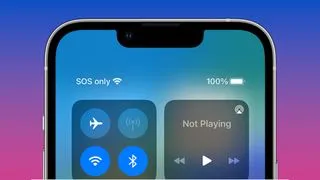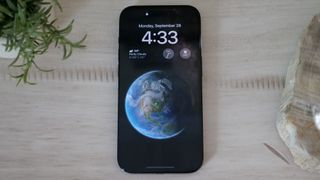
Encountering an “SOS” message on your iPhone can be a worrisome sight, but fear not, it doesn’t indicate an accidental emergency trigger. The “SOS” alert in question appears in your iPhone’s status bar where the cellular signal strength is usually shown. While we can guide you on activating an SOS alert, this article focuses on explaining the significance of “SOS” on the iPhone status bar and how to address it.
What does SOS on iPhone mean?
The SOS icon on your iPhone signals a loss of cellular connection, limiting you to making emergency calls or texts only. On iPhone 13 or older models, if you move out of SOS range, it changes to “No service.” With iPhone 14, satellite SOS functionality was added, so unless you’re exploring caves or diving deep, you won’t see that message.
SOS on iPhone due to a service outage
If you’ve landed here seeking answers about the iPhone SOS message, chances are you’re facing a service disruption with your cellular provider. This issue often drives a surge in traffic to our page, emphasizing the importance of verifying your provider’s service status when experiencing difficulties.
“How do I check for service outages?”
To stay informed about potential service disruptions in your area, check your cellular provider’s service status. Some providers may offer estimated times for issue resolution. While not all providers have outage trackers, you can explore alternative resources if you have a Wi-Fi connection. Sign up for our comprehensive reviews, valuable tips, exclusive deals, and latest news updates straight to your email.
If your network isn’t listed above, no need to worry. Although your cellular provider is the best source for accurate outage updates, various third-party websites are available to monitor real-time user reports on service disruptions. These platforms provide immediate details on any issues, including the number of reports and their respective locations.
To monitor your cellular network status, we suggest using Down Detector. Alternatively, you can explore other options like Down For Everyone Or Just Me?, Is The Service Down?, and Outage.Report.
“My network has a service outage, how long will it last?”
The magnitude and extent of an outage can greatly differ based on the type of fault affecting a network. In February 2024, we monitored a problem affecting the AT&T network, leading to widespread cellular disruption nationwide. This issue caused potentially millions of AT&T customers (including those using Cricket Wireless and Straight Talk) to see the iPhone SOS indicator in Texas, Illinois, Georgia, Washington, and Kansas.
This specific issue persisted for over 12 hours, causing significant disruption. Even 911 calls to emergency services, usually possible during an iPhone SOS state, were impacted.
Reportedly, AT&T attributed the fault to the incorrect application and execution of a process during their network expansion. While such network outages are rare, they can lead to prolonged service disruptions, requiring more time for resolution compared to other issues.
Typically, service disruptions stem from severe weather, network overload, or scheduled maintenance. These outages usually last from minutes to a few hours and have a localized impact rather than a national one.
If you encounter the iPhone SOS warning, it’s advisable to check for notifications from your carrier regarding any planned maintenance or work in your vicinity.
Other outages, like tower damage or equipment failures, may affect a smaller area but could last longer. During such instances, you may experience complete service loss or intermittent connectivity until the issue is rectified.
“I don’t see any reported service outages, what should I do?”
If you experience service issues not reflected in current outage reports, reach out to your cellular provider’s customer service or technical support promptly. Your timely report could be crucial in enabling a swift response. Even if there are no service disruptions at your location, your provider can assist in troubleshooting and resolving any problems. Contact your cellular provider through various channels like X/Twitter, webchat, email, or phone. Explore the links below for ways to connect with your cellular network provider.
- AT&T
- Website | X/Twitter | Phone: 1-800-331-0500
- T-Mobile
- Website | X/Twitter | Phone: 1-800-937-8997
- Verizon
- Website | X/Twitter | Phone: 1-800-837-4966
How can you fix SOS on iPhone?
To address the SOS issue in iPhone messages, returning to an area with stronger service is the quick fix. Yet, if you’re in a spot with a known past connection, the phone may not be registering it correctly.
While we’ve covered steps to troubleshoot and contacting your network provider for further assistance, you might resolve the issue independently. If you want to attempt a DIY fix, these instructions can help.
Begin by swiping down from the upper-right corner of your screen, tap the green Cellular Data icon to disable it, then tap it again to reactivate. If this fails to re-establish the connection, perform a soft reset on your iPhone. Press and hold the side button and lower volume button simultaneously for roughly 3 seconds to bring up a new screen with power options. Slide the top power icon to the right to power off the phone. Once it shuts down, wait briefly, then hold the side button to restart the device.

To resolve this issue, ensure your phone is within range of a connection to remove the SOS from your status bar. If you’re facing this problem repeatedly in areas with good connectivity, your phone might have a faulty SIM card or slot, necessitating a visit to your carrier or the Apple store. For iPhone XR to the latest iPhone 15 models, consider switching to eSIM. My daughter’s iPhone 13 Pro encountered this very issue. While transitioning to eSIM initially posed challenges, it has functioned flawlessly for a year now, with no SOS alerts after being a common sight daily.
More from Laptop Mag
- MacBook Air M4: Everything we know so far
- How to hide caller ID on iPhone — make anonymous phone calls
- MacBook Air vs. MacBook Pro: Which Mac should you buy in 2024?
Sean Riley has a wealth of experience in the tech industry, spanning over a decade. As a versatile freelancer, he has delved into diverse topics such as phones, wearables, tablets, smart home devices, laptops, AR, VR, mobile payments, fintech, and beyond. At Laptop Mag, Sean shines as the go-to expert for mobile technology, specializing in phones and wearables. Here, you’ll discover a plethora of his work, including news, reviews, insightful how-to guides, and opinion pieces on these subjects. Laptop Mag serves as the perfect platform for Sean’s wide-ranging interests, offering in-depth reviews and updates on the newest laptops, VR games, computer accessories, and a comprehensive coverage extending from NFTs to cybersecurity and beyond.
